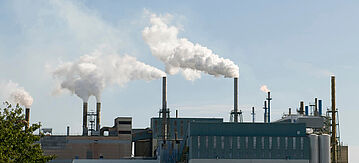Minister Hendricks: all sectors must deliver on climate action
The Federal Environment Agency's (UBA) short-term forecast shows that higher exports of electricity, cooler weather conditions compared to the previous year and lower fuel prices led to a slight increase in greenhouse gas emissions. According to the report there was a rise in emissions of 6 million tonnes to 908 million tonnes of CO2 equivalents, which equates to 0.7 percent, but overall emissions have dropped by 27.2 percent compared to 1990.
CO2 emissions have gone down in electricity generation. Coal-based power generation did not increase despite the largest nuclear power station, Grafenrheinfeld, being shut down in 2015. The share of renewable energies in power generation grew considerably to 30 percent. However, this did not lead to a corresponding reduction in CO2 emissions due to the rise in electricity exports which hit a record level of 50 terawatt hours in 2015.
Federal Environment Minister Barbara Hendricks explained "The bad news is that the progress we made in climate action by expanding renewable energies has been partly eroded by the persistently high generation of coal-based power. This is due to the overcapacities generated in coal-based power plants. The good news is that we are already taking steps towards a solution. Statistics clearly show that a gradual phase-out of coal-based power generation can be achieved without any bottlenecks in the power supply. From 2017 onwards, we will be taking lignite-fired power plants off the grid and start transferring them to a reserve. This represents an important change in the course of our climate action."
The impact of the Climate Action Programme, adopted in December 2014, has not yet been reflected in the data as many of the measures contained in the programme were first introduced over the course of 2015.
The primary cause for the rise in emissions were the cooler weather conditions compared to the previous year which meant there was a greater need for heating energy. Households and other small-scale consumers used natural gas in particular, which increased emissions by 4.5 million tonnes.
On this point, the minister noted: "The figures indicate that the weather still has a major influence on our climate balance. This shows that there is still enormous potential to be unlocked in the heating sector, in particular with regard to energy efficiency in buildings. This is where we have work to do. I have therefore approved an increase in and more effective use of funds for energy-related upgrades for buildings under the Climate Action Programme."
Another cause of higher emissions was the transport sector - transport-related greenhouse gas emissions increased by 1.5 percent to 163.6 million tonnes of CO2. The reasons for this were lower fuel prices in general and the considerably higher volume of freight traffic, especially on roads.
UBA President Maria Krautzberger stated: "The latest data reconfirms the fact that we can only achieve our climate targets by using alternative forms of mobility. We need, among other things, better bus and train services, more electric cars and bikes and to promote walking and cycling more. Lastly, we need to make the transport sector climate neutral." Krautzberger added that there is a need for research and development in this area, for instance, on the conversion of power from renewable energy sources into fuels (power to gas/power to liquid).
Emissions from industry in 2015 rose by 0.8 million tonnes of CO2 equivalents. In the waste sector, emissions dropped by almost 0.6 million tonnes of CO2 equivalents compared to the previous year which can be attributed to improvements in landfilling.
In agriculture, greenhouse gas emissions rose by 1.3 percent to 66.9 million tonnes of CO2 equivalents. This rise was down to nitrous oxide emissions from the increased use of fertilisers and methane emissions as a result of higher animal numbers in cattle and sheep farming. These greenhouse gases impact the climate to different extents and are thus better compared when emissions are converted to CO2 equivalents.
The data for the short-term forecast is an initial detailed estimate derived from a system of model extrapolations and trend updates based on the detailed calculations published in January for the year 2015. It is also based on initial survey data published for 2015 on primary energy consumption by the Working Group on Energy balances (AGEB) and industry associations.

